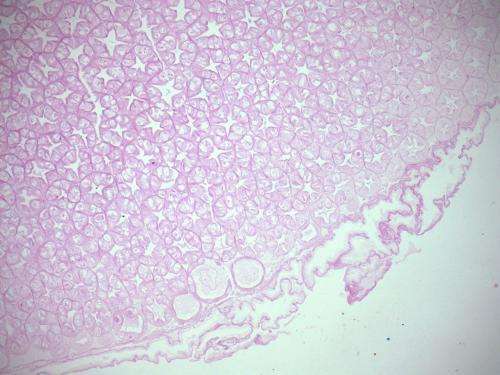The pancreas: type 1 diabetes is caused when the pancreas fails to produce enough insulin because the necessary beta-cells have been destroyed by the body’s immune system. Credit: Rafael Mondini
IDENTIFYING a genetic weakness that causes type 1 diabetes in children has opened the way for development of a treatment capable of preventing the disease.
The genetic weakness has been pinpointed by researchers at Perth's Harry Perkins Institute of Medical Research working as part of a global consortium, who studied the mechanisms for the gene cathepsin H (CTSH) to influence beta-cells in the pancreas of type 1 diabetics.
Type 1 diabetes is caused when the pancreas fails to produce enough insulin because the necessary beta-cells have been destroyed by the body's immune system.
The research shows CTSH may affect disease progression by modulating the survival and function of pancreatic cells which are the target of autoimmune assault.
However, the exact way CTSH works in beta-cells has not been determined—higher levels of CTSH has been found to be beneficial but a weakness in the CTSH gene can make cells more vulnerable to an autoimmune response.
The Institute's Grant Morahan says the research investigated over 200 blood samples at the gene's RNA and protein levels from patients worldwide, to see how gene expression changed.
"Our results showed the CTSH gene was active but we had to go to the next step and show that RNA was translated into protein—that was really dotting the 'I's and crossing the 'T's," Prof Morahan says.
"Type 1 diabetes is due to the insulin producing beta-cells being destroyed by an autoimmune response and this particular variant in the CTSH gene makes those cells more vulnerable to attack from the immune system.
"This is crucial, because now we know the exact molecular weakness in beta cells."
CTSH gene presence also protects beta-cells
The WA team's Danish collaborators showed higher levels of the CTSH gene protected the body's antibody-producing beta-cells from dying when attacked by the immune system. Those people with higher levels had better cell function and slower progression to type 1 diabetes.
Professor Morahan says proving this protective capability means it is possible to develop drugs either to increase production of the gene in beta-cells, or to mimic the function of CTSH in beta cells and prevent the disease.
"We should now try and find some way of blocking the biochemical pathway to cell death that the CTSH molecule participates in, so that's what people will be looking at in the next stage," he says.
"Type 1 diabetes affects children and they have it for the rest of their lives so the goal of our research is to come up with a way to prevent children from getting diabetes."
More information: "CTSH regulates β-cell function and disease progression in newly diagnosed type 1 diabetes patients." Tina Fløyel, et al. PNAS DOI: 10.1073/pnas.1402571111
Journal information: Proceedings of the National Academy of Sciences
Provided by Science Network WA




















